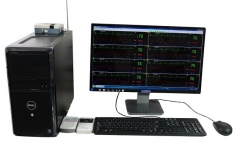Wechat QR code

TEL:400-654-1200

TEL:400-654-1200

The monitor manufacturer's ECG monitor has brought a lot of convenience to clinical operations, but is it really easy to master? We will now talk about the four most common items of ECG monitors.
Four of the most commonly used items for ECG monitors
Oxygen
Patients often have "low blood oxygen" needs. According to the monitoring principle of the monitor, peripheral circulation, nail polish, and poor skin cleanliness of the patient will all affect the monitor's judgment. If the patient's blood oxygen level is very low, the patient's condition should be investigated, especially in part. When conditions permit, survey curves should be surveyed. A very regular curve is of reference value.
If you measure blood oxygen on the same side of the blood pressure measurement, the measurement value will naturally decline. If the condition is not allowed, measure blood oxygen after measuring blood pressure for a period of time. There is also a common condition in patients with shock and low blood pressure. Because of their peripheral blood supply, peripheral blood oxygen must fall.
In fact, this does not necessarily mean that the patient really has hypoxemia. If the patient is conscious, the question and answer is correct, and there is no significant dyspnea, but the measured blood oxygen is very low, then, do not worry first, to see if there is a misuse, or if the patient has congenital heart disease. On the contrary, normal peripheral oxygenation does not necessarily explain the patient's normal condition. High hemoglobin is a good example.
If blood oxygen is inconsistent with the patient's condition, there are three things that can be done: the top spot, acknowledging shocks, sphygmomanometer cuff compressions, poor skin cleanliness, and other abnormalities; second, history of recovery, congenital heart disease, old age COPD is often hypoxemic; third, if no reason can be found, then make a blood analysis, as expected, blood gas analysis as a gold target can also help analyze the causes of abnormal blood oxygen.
Monitor manufacturers
blood pressure
Due to the principle of measurement, the monitor often overestimates the "low value" and overestimates the "high value". In other words, if the patient's true blood pressure is 180 / 100 mm Hg, the monitor may measure 190 / 110. Mm Hg; if the patient's blood pressure is 70 / 40 mm Hg, the measurement may be 60 / 30 mm Hg. In addition, the width and tightness of the cuff will affect the judgment.
There is also a simple neglected reason: "The distance for active measurement is set too close", such as 10 minutes, 15 minutes, and sometimes even 5 minutes. Of course, when blood pressure control drugs such as sodium nitroprusside and aniline are used to control blood pressure, it may be necessary to do this in a short period of time when rescuing shock and fluid recovery.
The processing method is very simple: see the use of the monitor clarified. General instruments will indicate the scale of blood pressure measurement. If you exceed the scale, you will honestly pick up a stethoscope and sphygmomanometer and test it yourself. In addition, in addition to rescue, try not to set the measurement distance too short. In addition to measurement data banned, it will also cause harm to patients.
Breathing times
This is one of the most "fail-safe" goals. There are many factors that affect it. In general, I will look at the number of patients' breathing. Under normal circumstances, this goal can basically be "negligence."

Heart rate
Personally think that this is the "most useful" goal in the monitor. Heart rate is a barometer of the severity of many diseases. In addition, heart disease rate waveforms are used to distinguish between severe diseases such as myocardial infarction and arrhythmia.
The “failure” of the heart rate waveform: The mechanism of the ECG monitor is different. Generally, it counts the number of QRS waveforms over a period of time, and then calculates the heart rate. If the patient has a premature beat, the data displayed by the monitor will often change. Sometimes, because the lead may be high in T waves, the QRS and T wave heights may be very close, and the instrument will “fault” and use them as heart rate. At this moment, the heart rate will double, causing unnecessary “shock”.
In addition, the waveform of ECG monitoring is generated by imitating the lead, and it is different from the conventional waveform of ECG (ECG needs to connect limbs, and the general monitor is only connected to the chest). Therefore, the similar ST segment elevation waveform seen on the monitor may not be a problem.
Summarize 3 points to easily master ECG monitoring
1. If you study the instruction manual, as long as the ECG monitor is “clear at a glance”, then you can do it comfortably;
2. Strictly standard operations to prevent measurement and error determination caused by human factors;
3. The most important thing is: The monitor has abnormal goals. The best way is to immediately investigate the condition of the patient, rather than being far away. See the doctor's advice. What we treat is the disease. The patient is being investigated. The instrument assisted us in the diagnosis and we must not be diagnosed by the instrument!